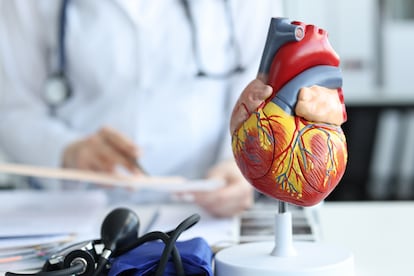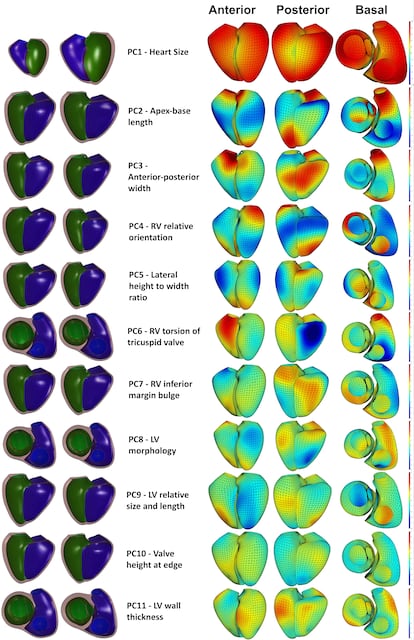Small? Spherical? Tilted? The shape of your heart reveals your risk of cardiovascular disease
New study links more spherical heart shapes to higher likelihood of atrial fibrillation and identifies 14 new genes associated with heart conditions

The simplicity of the symbol we use to represent the heart (♥) stands in stark contrast to the complexity of the organ itself, and bears little resemblance to its true shape. An international team of scientists, led by experts from Spain, has created three-dimensional models of the heart’s full structure using magnetic resonance images. This groundbreaking work was done for over 40,000 individuals, each with a unique heart shape at a specific point in their lives. The team then examined the genetic factors behind these distinct morphologies, ultimately linking both the shape and genetics of the heart to the cardiovascular conditions they were prone to. In their findings, the researchers discovered that more spherical heart shapes are associated with a higher risk of atrial fibrillation.
“For each individual, we created a complete representation of their heart, including both the left and right ventricles, and in diastole, with the heart relaxed after contraction,” explains Patricia B. Munroe, professor of molecular medicine at Queen Mary University of London and one of the authors of the study published in Nature Communications.
While other teams have used resonance images to extract simple measurements, such as the thickness of the ventricular wall or the heart’s size, “no one had made a three-dimensional representation like this,” says Julia Ramírez, a researcher at the University of Zaragoza and another lead author of the study.
From the 40,000 MRI scans — sourced from the UK Biobank, a vast public database containing health and genetic information on half a million Britons — the team digitally segmented the heart images and extracted morphology measurements. These were then grouped into 11 mathematical coordinates that represent the heart’s complete shape. The first coordinate corresponds to size, the fourth to orientation (how inclined the heart is with respect to the vertical axis), the fifth to sphericity, and so on, with the final coordinate determining thickness. Cardiologists typically measure other parameters in MRIs, such as the volume of the ventricles, the thickness of the myocardium, or the size of the atrium.
People perceive the world in three dimensions, so a model as multidimensional as the one in this research is impossible to visualize and very difficult to imagine. However, the human imagination has, over time, found a way to relate the heart to the popular symbol, which consists of two semicircles and a downward-pointing triangle. This iconic shape dates back to the Ancient Greek city of Cyrene — in modern-day Libya — where, between the 6th and 3rd centuries BC, coins circulated depicting seeds in that distinctive shape. These were silphium seeds, from a plant now considered extinct, silphium. At the time, it was associated with Aphrodite, the goddess of love and pleasure, perhaps because the Greeks used silphium as an aphrodisiac, as well as a culinary condiment. Additionally, the plant had medicinal uses ranging from promoting fertility to, interestingly, serving as a form of contraception.
Genes and shape
After constructing the detailed, abstract representation of 40,000 hearts across 11 dimensions, the researchers conducted a genetic study on cardiac morphology using the cohort’s data to explore the biological basis behind heart shape. “Essentially, we asked the question: Are these 11 major components heritable? And the answer was yes,” Munroe explains.
In total, they identified 45 areas of DNA linked to heart shape. Many of these were already known, such as those influencing the thickness of the ventricular wall or the size of the heart, but 14 turned out to be completely unknown. “What these genes are doing, their function, we still don’t know. In the article, we highlight some of the genes, but these 14 had never been associated with any cardiac disease or trait, not even with the heart. So, it opens up a whole new area of biology,” says Munroe.
“It was known that genetics influenced simple parameters — such as how thick your ventricle is or how high it is — but not that it defined the entire morphology in such a detailed way. This is the first time,” adds Ramírez. Since the researchers also had information on the participants’ health history, they analyzed who had developed certain diseases and what types. “This way, we were able to close the circle between the genetic signal, changes in the morphology of the heart, and the development of later diseases,” Ramírez explains.
The team found that smaller hearts are associated with a higher risk of diabetes, confirming previous studies that pointed to the same finding. “As for sphericity, we see that people with a more spherical heart appear to be at a higher risk of atrial fibrillation. There are other associations, but they are not as strong. This confirms that the relationship between heart shape and cardiovascular disease is significant,” Munroe says.

“We now know that genetic information can be used to determine if someone has an abnormal heart that predisposes them to risk, offering a more affordable screening method,” says Ramírez. “Fifteen years ago, I would have said no, as genetic screening was expensive, but now it’s much cheaper than an MRI.”
For Munroe, this study “provides valuable information to what is measured in clinical settings by conventional measures.” She explains: “These new shape measures are linked to disease outcomes, so it’s clear they are important.”
One commonly used indicator is the left ventricular ejection fraction, which relates to the heart’s pumping capacity. The British researcher explains that her shape models “can provide more insight to better predict individuals at risk. However, at this stage, we are still in the research phase. Perhaps in the future, some of these shape components will be important for [diagnosing] certain diseases. We don’t know yet. But it contributes to the growing knowledge of biomarkers that could aid in predicting cardiovascular risk.”
In search of clinical use
As a next step, the team is examining resonance images recorded during systole, when the heart contracts. This approach is expected to provide more genetic and morphological information, which has yet to be published.
For Ana García Álvarez, Head of the Cardiology Service at the Hospital Clínic de Barcelona and the Translational Research Group on Heart Failure and Pulmonary Hypertension at the National Centre for Cardiovascular Research, who was not involved in the study: “The originality of this work lies in its integrated approach to cardiac structure. They have a very large cohort and integrate the sophistication of defining cardiac typologies with magnetic resonance imaging, and link that data to the entire genome. What’s interesting is whether these genetic variants could predispose me to higher cardiovascular risk, which I can then prevent. And, of course, we’re still somewhat far from this goal.”
According to the researcher, while genetics play a role in cardiovascular health, lifestyle factors have a much greater impact. “In my experience, 80% of cardiovascular health is influenced by the environment, and 20% by genetics, although this obviously varies,” says García Álvarez. “We must recommend a healthy lifestyle to everyone: we should all exercise, avoid smoking, and manage our cholesterol levels.”
“Perhaps some of the 14 genes linked to heart shape will prove to have a significant impact in the future that could be treated,” adds the cardiologist. “It’s also possible they will have no prognostic value. This is what we need to continue investigating.”
Sign up for our weekly newsletter to get more English-language news coverage from EL PAÍS USA Edition
Tu suscripción se está usando en otro dispositivo
¿Quieres añadir otro usuario a tu suscripción?
Si continúas leyendo en este dispositivo, no se podrá leer en el otro.
FlechaTu suscripción se está usando en otro dispositivo y solo puedes acceder a EL PAÍS desde un dispositivo a la vez.
Si quieres compartir tu cuenta, cambia tu suscripción a la modalidad Premium, así podrás añadir otro usuario. Cada uno accederá con su propia cuenta de email, lo que os permitirá personalizar vuestra experiencia en EL PAÍS.
¿Tienes una suscripción de empresa? Accede aquí para contratar más cuentas.
En el caso de no saber quién está usando tu cuenta, te recomendamos cambiar tu contraseña aquí.
Si decides continuar compartiendo tu cuenta, este mensaje se mostrará en tu dispositivo y en el de la otra persona que está usando tu cuenta de forma indefinida, afectando a tu experiencia de lectura. Puedes consultar aquí los términos y condiciones de la suscripción digital.
More information
Archived In
Últimas noticias
Most viewed
- Reinhard Genzel, Nobel laureate in physics: ‘One-minute videos will never give you the truth’
- Oona Chaplin: ‘I told James Cameron that I was living in a treehouse and starting a permaculture project with a friend’
- Pablo Escobar’s hippos: A serious environmental problem, 40 years on
- Why we lost the habit of sleeping in two segments and how that changed our sense of time
- Charles Dubouloz, mountaineering star, retires at 36 with a farewell tour inspired by Walter Bonatti










































